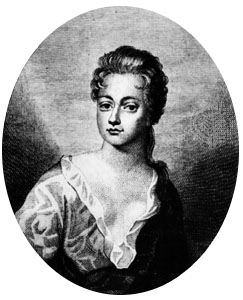Anne Bracegirdle facts for kids
Anne Bracegirdle (born around 1671, died 12 September 1748) was a very famous English actress from the 1600s and early 1700s. She was known for her talent and became a favorite with audiences.
Contents
About Anne Bracegirdle
Anne Bracegirdle was born in Northamptonshire, England. She was likely born around 1671, though some records suggest a slightly different year. From a young age, she was probably raised by two well-known actors, Thomas Betterton and Mary Betterton.
Many people believe she was the "little girl" mentioned in play advertisements before 1688. This was for a theater group called the Duke's Company, where Thomas Betterton was a big star. Because of this, it's thought she started acting very early in her life.
Her Acting Career Begins
Anne Bracegirdle's name first appeared in official theater records in 1688. By then, the Duke's Company had joined with another group to form the United Company. We know some of her early roles from old lists of play casts.
In 1689, she played Semernia in a play called The Widow Ranter. This was a "breeches role," meaning she dressed as a man. She often played these types of parts. By 1690, she was taking on big roles like Lady Anne in Shakespeare's Richard III and Desdemona in Othello.
She also performed in many of the main female roles in plays written by William Congreve. Soon, Anne became one of the most important actors in her company. Audiences loved her, which is why she often spoke the prologue (introduction) and epilogue (conclusion) of plays.
In 1705, she acted in a play called Ulysses, a tragedy written by Nicholas Rowe.
Leaving the Stage
After 1705, another talented actress named Anne Oldfield became very popular. Audiences started to prefer Anne Oldfield. Because of this, Anne Bracegirdle decided to stop acting. She only returned to the stage once, in 1709, for a special show to help Thomas Betterton.
A Famous Story
A writer named Colley Cibber, who was also an actor, greatly admired Anne Bracegirdle. He once said his biggest dream was to act as a "Lover with Mrs. Bracegirdle."
In 1692, a dramatic event happened involving Anne. Two men, Captain Richard Hill and the actor William Mountfort, were both interested in her. Captain Hill, feeling jealous, tried to take Anne away with the help of Lord Mohun and his friends. During this event, William Mountfort, who was thought to be Anne's boyfriend, was sadly killed in the street.
Captain Hill escaped, but Lord Mohun was put on trial and found not guilty. Both men later died in violent ways years later. People said that all the attention from this event actually helped Anne's acting career. Even in 1702, she was still called the "celebrated virgin."
Anne Bracegirdle asked to be buried in Westminster Abbey, a very famous and important church in London, and her wish was granted.
Selected Roles
- Antelina in The Injured Lovers by William Mountfort (1688)
- Semernia in The Widow Ranter by Aphra Behn (1689)
- Urania in Alphonso, King of Naples by George Powell (1690)
- Biancha in The Successful Strangers by Thomas Shadwell (1690)
- Cleomira in Distressed Innocence by Elkanah Settle (1690)
- Maria in Edward III by William Mountfort (1690)
- Miranda in The Mistakes by Joseph Harris (1690)
- Charlotte in Sir Anthony Love by Thomas Southerne (1690)
- Julia in The English Frier by John Crowne (1690)
- Marcelia in The Treacherous Brothers by George Powell (1690)
- Emmeline in King Arthur by John Dryden (1691)
- Tamira in Bussy D'Ambois by Thomas D'Urfey (1691)
- Mrs Sightly in The Wives Excuse by Thomas Southerne (1691)
- Mirtilla in Love for Money by Thomas D'Urfey (1691)
- Cleora in Cleomenes, the Spartan Hero by John Dryden (1692)
- Rosamund in Henry II by William Mountfort (1692)
- Phoebe in The Marriage-Hater Matched by Thomas D'Urfey (1692)
- Clara in The Volunteers by Thomas Shadwell (1692)
- Araminta in The Old Bachelor by William Congreve (1693)
- Lady Trickitt in The Maid's Last Prayer by Thomas Southerne (1693)
- Mariana in The Female Virtuosos by Thomas Wright (1693)
- Fulvia in The Richmond Heiress by Thomas D'Urfey (1693)
- Camilla in The Married Beau by John Crowne (1694)
- Celidea in Love Triumphant by John Dryden (1694)
- Clarismunda in The Ambitious Slave by Elkanah Settle (1694)
- Villeria in The Fatal Marriage by Thomas Southerne (1694)
- Angelica in Love for Love by William Congreve (1695)
- Angelica in The She-Gallants by George Granville (1695)
- Lausaria in Cyrus the Great by John Banks (playwright) (1695)
- Belinda in The Provoked Wife by John Vanbrugh (1696)
- Camilla in Boadicea, Queen of Britain by Charles Hopkins (1697)
- Mrs Beauclair in The Innocent Mistress by Mary Pix (1697)
- Placentia in Beauty in Distress by Peter Anthony Motteux (1698)
- Lucia in The Squire of Alsatia by Thomas Shadwell (1698)
- Locris in Friendship Improved by Charles Hopkins (1699)
- Lovisa in The False Friend by Mary Pix (1699)
- Amestris in The Ambitious Stepmother by Nicholas Rowe (1700)
- Millamant in The Way of the World by William Congreve (1700)
- Guinoenda in Love's Victim by Charles Gildon (1701)
- Fulvia in The Ladies Visiting Day by William Burnaby (1701)
- Cytheria in The Double Distress by Mary Pix (1701)
- Selima in Tamerlane by Nicholas Rowe (1701)
- Orinda in As You Find It by Charles Boyle (1703)
- Caesario in Love Betrayed by William Burnaby (1703)
- Angelica in The Gamester by Susanna Centlivre (1705)
- Flippanta in The Confederacy by John Vanbrugh (1705)
- Semanthe in Ulysses by Nicholas Rowe (1705)
- Lucinda in The Platonick Lady by Susanna Centlivre (1706)
- Laura in Adventures in Madrid by Mary Pix (1706)
See also
 In Spanish: Anne Bracegirdle para niños
In Spanish: Anne Bracegirdle para niños


